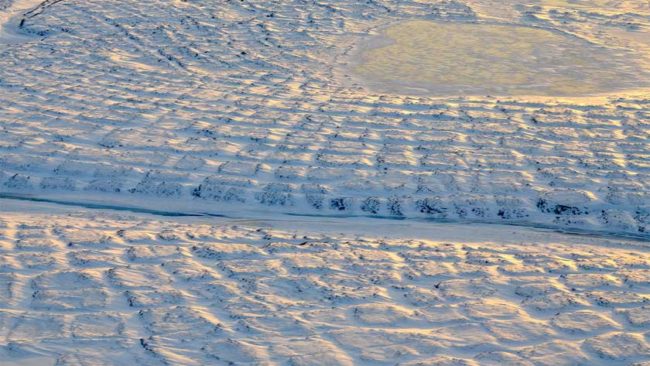
A new study has exposed the reality of a fear that has existing for some time. As the permafrost increasingly thaws the organic carbon that is trapped there gets released. A new study of this in Alaska has revealed that this is exactly what is now happening.
A paper that describes this study is available on PNAS, and is entitled “Carbon dioxide sources from Alaska driven by increasing early winter respiration from Arctic tundra“.
What is Going on?
In the Arctic regions the frozen soil contains thousands of years worth of accumulated carbon in the form of undecayed organic matter from dead vegetation. There is enough there to double the amount of CO2 in our atmosphere. What normally happens is that during the summer thaw it starts to decompose and emit CO2, then when winter arrives it all stops once it has frozen again. The summer vegetation also tends to absorb CO2 and so the amount absorbed has previously more than offset the amount emitted.
This is no longer true. The warming of the Arctic has resulted in an increase in the amount of CO2 now being emitted.
What exactly was measured?
They combined aircraft and tower observations of atmospheric CO2 with remote sensing data and meteorological products to derive year-round CO2 fluxes across Alaska during 2012–2014.
What this revealed were high rates of respiration during early winter (October through December). By looking back over records kept at Barrow, AK, it enables the researchers to conclude that CO2 emission rates from North Slope tundra have increased during the October through December period by 73% (± 11%) since 1975. That of course is correlated with rising summer temperatures.
Why is this discovery significant?
Most existing climate models do not account for this feedback loop, hence they probably underestimate current, and likely future, CO2 emissions and its associated impact. To quote the actual paper …
Many of the assessments of the changing CO2 seasonal amplitude are based on model simulations that appear not to capture the magnitude or trends in late season respiration, and, indeed, may predict an annual net sink for CO2 in Alaska where we observed net emissions. Our results suggest the need to reevaluate this work. The regional fluxes we infer show the importance of early winter fluxes, and the long-term CO2 data from the BRW tower indicate that early winter respiration rates have increased considerably over the past 41 y. These results imply that carbon release from organic matter may make a more important contribution to trends in the CO2 seasonal amplitude than expected from model simulations that may not capture the late season respiration correctly.
But decaying matter produces Methane not Carbon Dioxide … right?
No, not quite correct.When the matter is waterlogged and sits in low oxygen conditions, microbes do indeed produce methane, but when well-aerated, then you get CO2. Methane also breaks down into water and CO2.
Author Comments
The lead author of the new paper, Roisin Commane, an atmospheric researcher at SEAS, comments on this as follows …
“In the past, refreezing of soils may have taken a month or so but, with warmer temperatures in recent years, there are locations in Alaska where tundra soils now take more than three months to freeze completely,” said Commane. “We are seeing emissions of carbon dioxide from soils continue all the way through this early winter period.”
Co-author Colm Sweeney of the Cooperative Institute for Research in Environmental Sciences in Boulder, Colorado …
“Data from Barrow show steady increases of both atmospheric carbon dioxide and temperature in late fall and early winter, This new research demonstrates the critical importance of these long-term monitoring sites in verifying the subtle feedbacks, such as increases in carbon dioxide, which may amplify the unprecedented warming we are seeing throughout the Arctic.”
Co-author Steve Wofsy, Abbott Lawrence Rotch Professor of Atmospheric and Environmental Science at SEAS …
“Tundra soils appear to be acting as an amplifier of climate change, We need to carefully monitor what it’s doing up there, even late in the year when everything looks frozen and dormant”
Further Reading
- Harvard News
- Chris Mooney in the Washington Post
- Phys.org news
- NASA JPL News